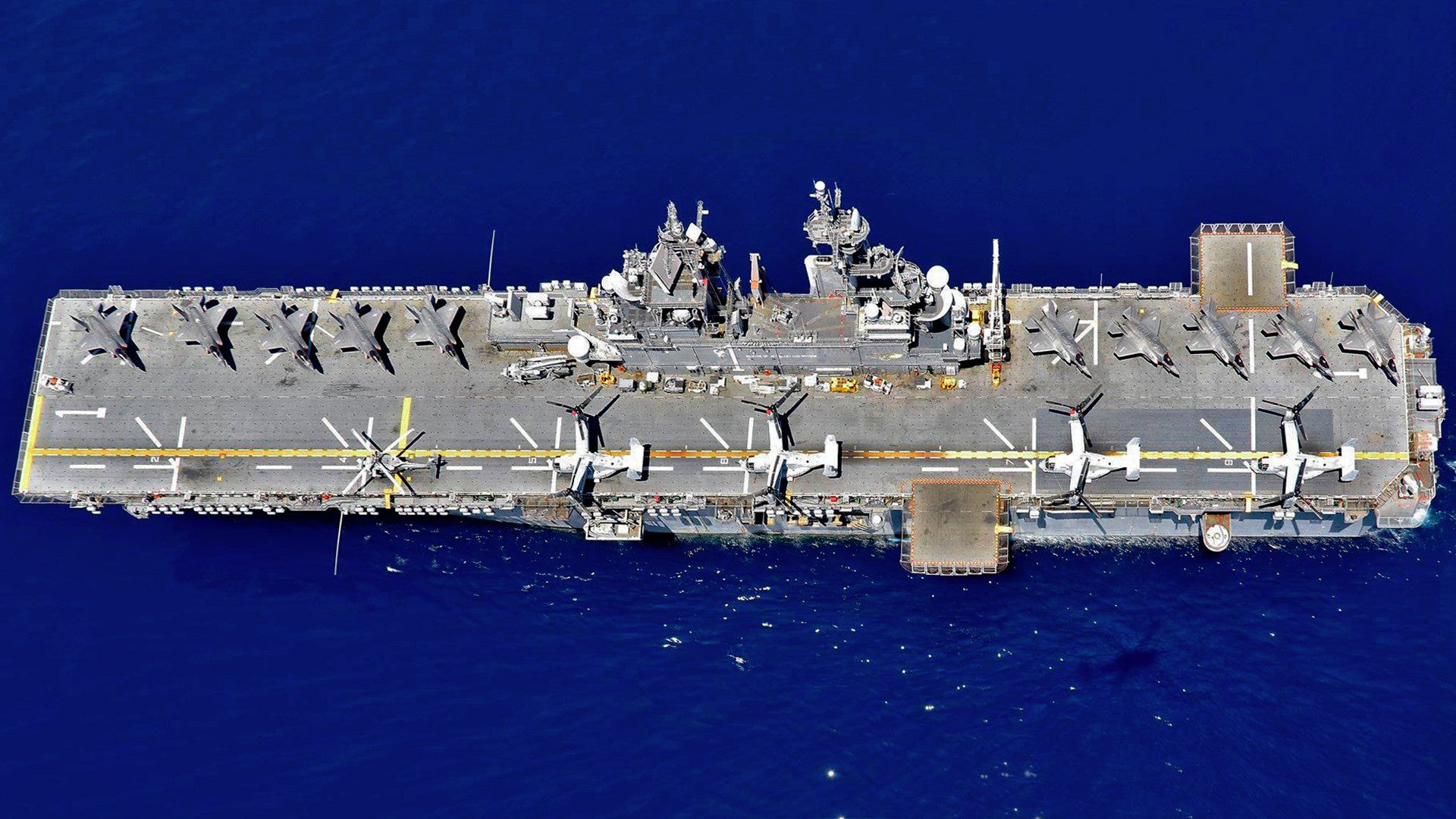The U.S. Navy’s first-in-class amphibious assault ship USS Wasp recently arrived in the Philippines for a major annual exercise carrying a U.S. Marine Corps contingent that includes at least 10 F-35B Joint Strike Fighters. This is a larger than average number of the combat jets than Wasp-class ships normally embark, but is a force structure that the Navy and Marines are looking to standardize. It’s also one that could help lay the groundwork for a future operating concept that could turn amphibious assault ships into light carriers, as necessary.
Wasp entered the Philippine port of Subic Bay on Mar. 30, 2019, ahead of the beginning of Exercise Balikatan 2019. The ship is carrying Special Purpose Marine Air-Ground Task Force Four (SPMAGTF 4), with the 4th Marine Regiment as the lead unit. The drills have occurred almost every year since 1991, with the exception of a hiatus between 1995 and 1999 due to a protracted dispute over the legal status of American troops deployed to the country during the exercise.
“During Balikatan 2019, U.S. and Philippine forces will conduct amphibious operations, live-fire training, urban operations, aviation operations, and counterterrorism response,” according to an official Navy statement. “[Wasp and SPMAGTF 4] Participating in Balikatan demonstrates their ability to quickly forward deploy in support of an ally should a crisis or natural disaster occur.”
This deployment is already notable since it is the first time F-35Bs, in any quantity, will take part in these drills. But it also appears to be one of the first times, if not the first time, a Marine task force has embarked aboard an amphibious assault ship with an air combat element, or ACE, in this particular F-35 heavy configuration.
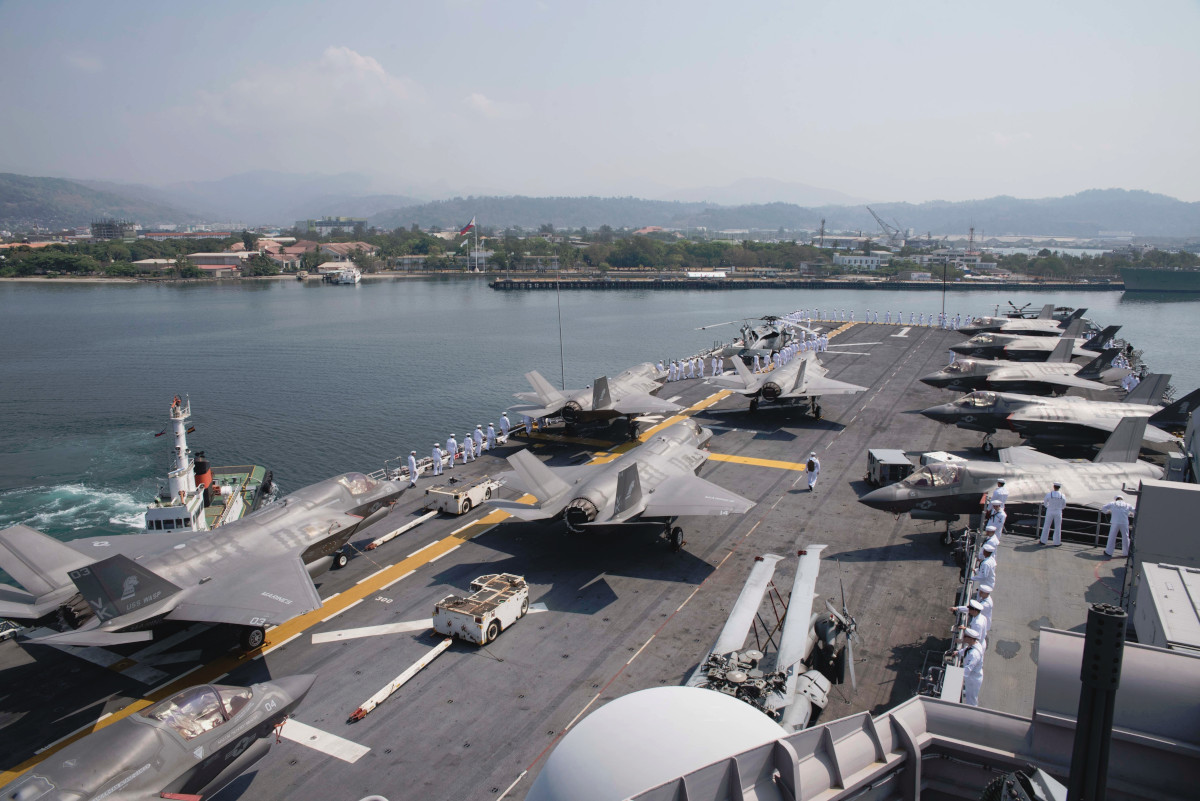
From what we can see on deck, Wasp’s current complement includes at least 10 F-35Bs from Marine Fighter Attack Squadron One Two One (VMFA-121), as well as four MV-22 Osprey tilt-rotors from Marine Medium Tiltrotor Squadron Two Six Eight (VMM-268) and a pair of MH-60S Sea Hawks from Helicopter Sea Combat Squadron Two Five (HSC-25). A more typical aviation component onboard an amphibious assault ship would only have around six F-35Bs, in favor of more MV-22s, as well as a detachment of CH-53E Sea Stallion heavy lift helicopters. This is by no means a hard rule, though, and Wasp-class ships have carried AH-1 gunships and UH-1 light armed utility helicopters at times, as well. It’s also important to mention that we don’t know how many more aircraft were in the ship’s hangar bay when the photos were shot.
The Marine aviation force in the Philippines right now reflects the development of high- and low-end force mixtures to respond to a variety of different crises, from a potential major conflict to a humanitarian disaster, that has been ongoing since at least 2012. How to employ the F-35B, which the Marine Corps officially said had reached initial operational capability in 2015, has been at the core component of crafting these concepts.
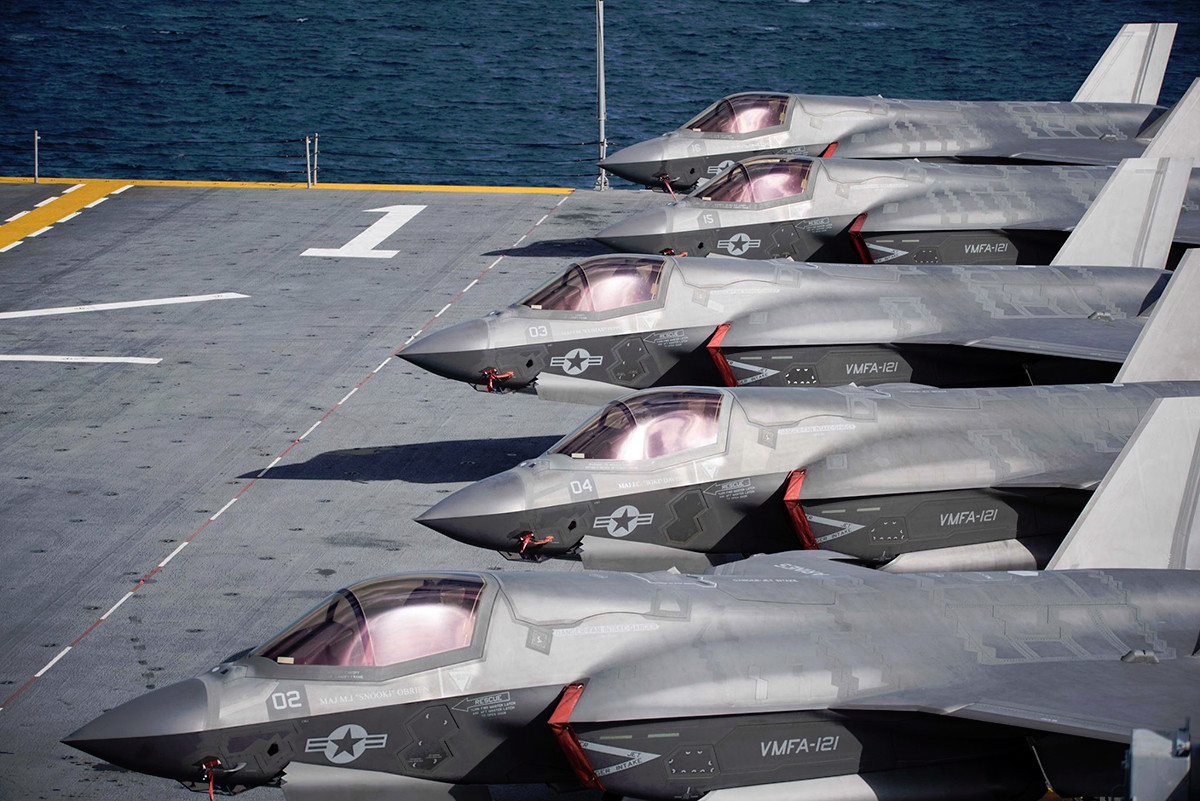
In the past, the Marines have outlined two basic ACE configurations for embarked Marine Expeditionary Units (MEU) on Amphibious Ready Groups (ARG) consisting of one Wasp-class amphibious assault ship, one San Antonio-class landing platform dock, and one Whidbey Island-class landing ship dock. One of these has six F-35Bs, 12 MV-22s, and four CH-53Es, while the other has eight F-35Bs, six MV-22s, and four CH-53Es.
Typically, the bulk of the ACE would be onboard the Wasp-class ship. The other two vessels would carry additional smaller helicopters, such as AH-1s and UH-1s, as well as unmanned aircraft, such as the RQ-21A Blackjack.
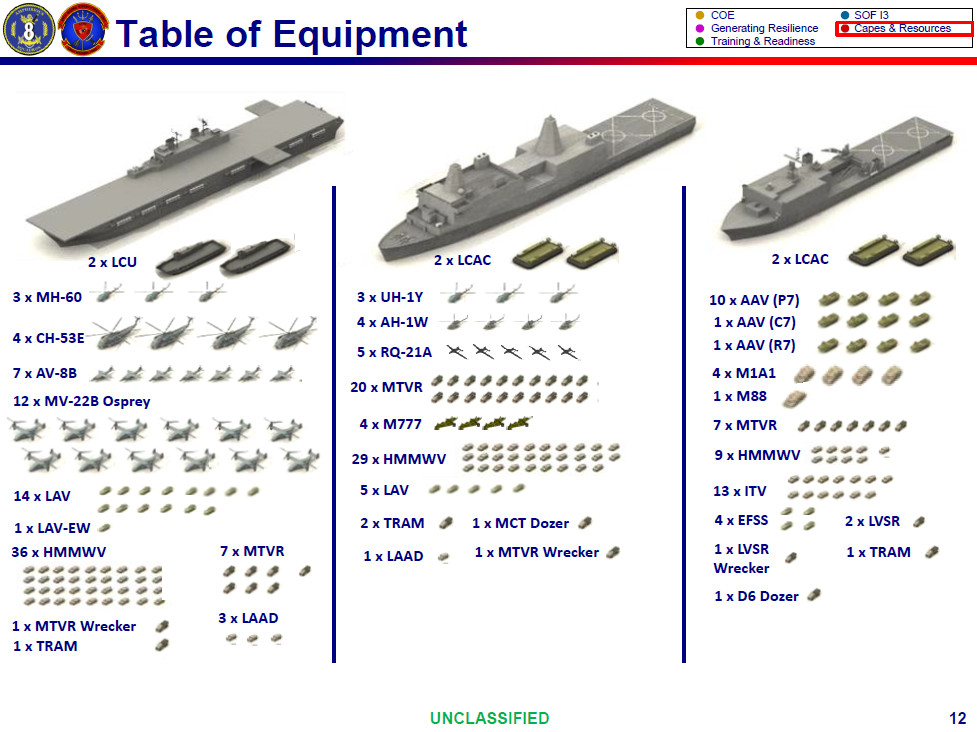
In the aforementioned configurations, the expectation is that CH-53Es will eventually give way to the new CH-53K King Stallions. Some number of MH-60s would be part of the full aviation complement in any case, as well.
“Both options require congested decks & restrict maintenance footprint,” a chart from the 2017 Marine Aviation Plan noted. This would help explain the apparent absence of CH-53Es entirely onboard Wasp at the moment, as well as the smaller number of MV-22s.
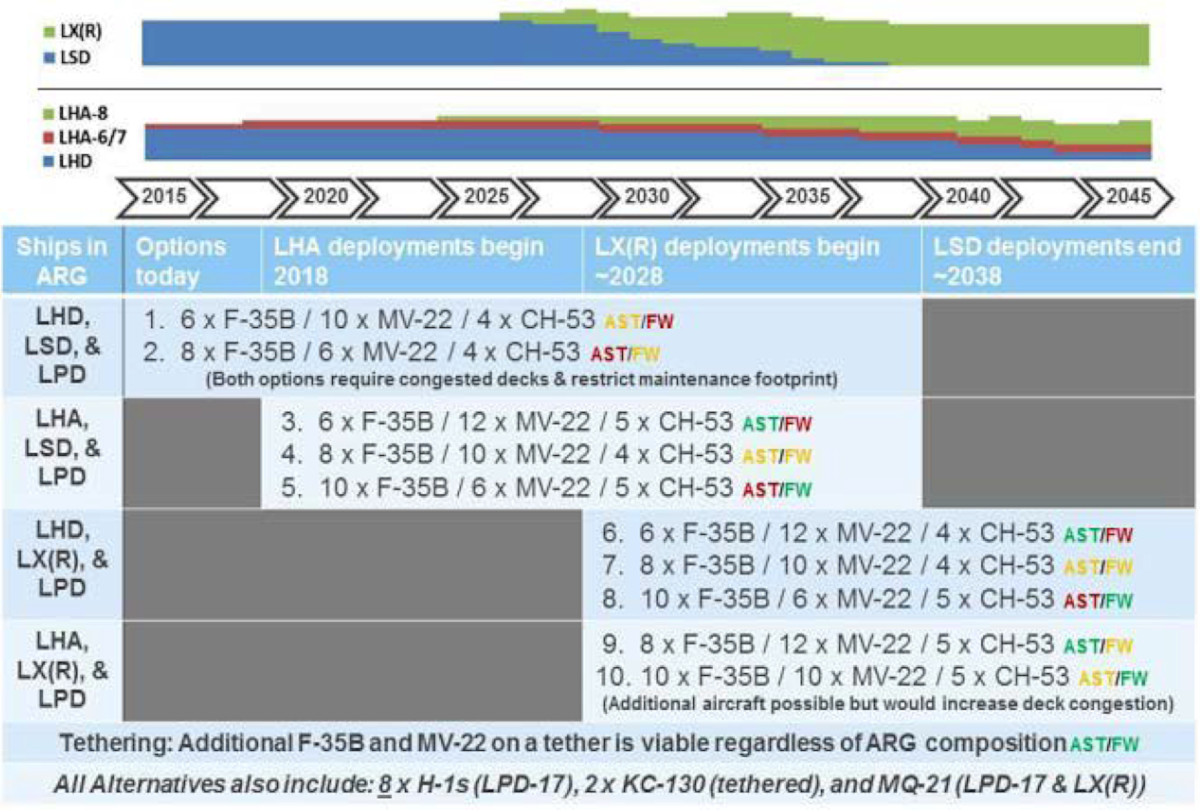
But amphibious assault ships deploying with 10 F-35Bs could become increasingly normal. In 2017, the Marines said the eventual plan was for ARGs with the aviation-focused USS America, and USS Tripoli, in the lead to be able to carry that many Joint Strike Fighters together with six MV-22s and five CH-53Es. There were also ACE configurations for these ships with only six or eight F-35Bs and more tilt-rotors and helicopters.
It’s not clear if this would necessarily work with the third America-class ship, the future USS Bougainville, which is basically in a sub-class of its own. It will feature greater deck space, but will have a well deck, a feature missing on the other two America class ships, reducing the size of its hangar and aviation-related spaces.
Still, the Marine Corps doesn’t feel that it will take an America-class amphibious assault ship to carry an aviation force with 10 F-35Bs forever. The Flight II San Antonio-class landing platform docks, previously known as the LX(R) and that will replace the Whidbey Island-class landing ship docks, are set to have improved flight deck capacity.
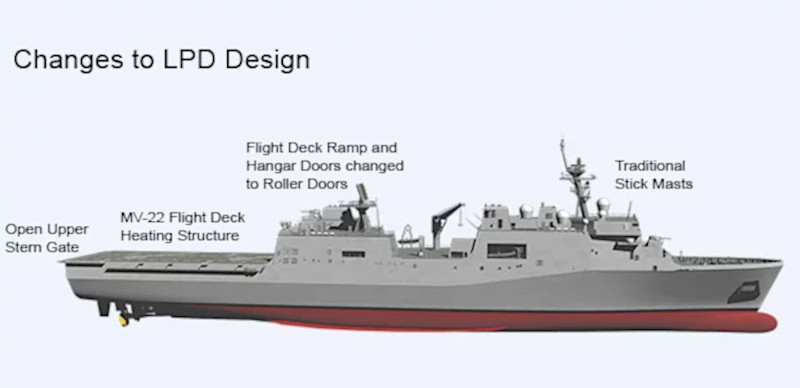
When the new Flight II San Antonios arrive, the Marines hope they can shift more tilt-rotors or helicopters to these ships in an each ARG. This, in turn, would free up space on the amphibious assault ships for more F-35Bs.
Beyond all this, the mix of at least 10 F-35Bs and four MV-22s on Wasp at present is in some ways a stepping stone toward an even more capable high-end light aircraft carrier concept, known as the “Lightning Carrier,” a reference to the F-35’s official name of Lightning II, which you can read about in more detail in our past feature on the concept linked here. This configuration was based on earlier experience with turning amphibious assault ships into Harrier Carriers with dozens of AV-8B Harrier jump jets.
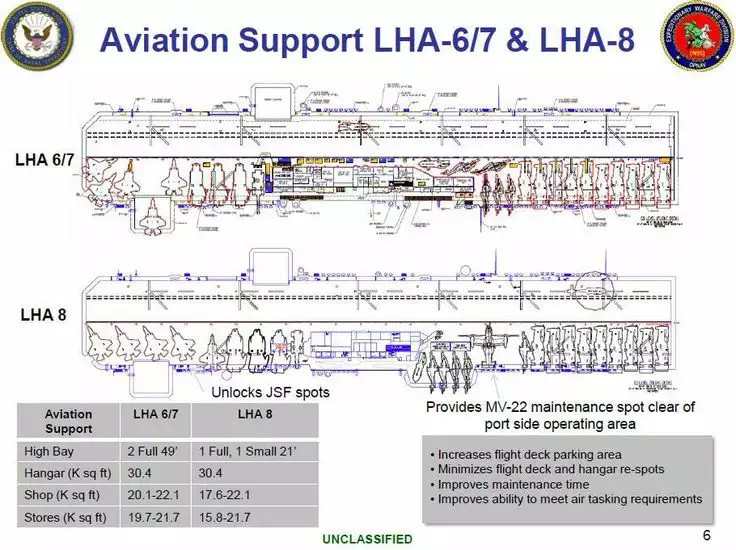
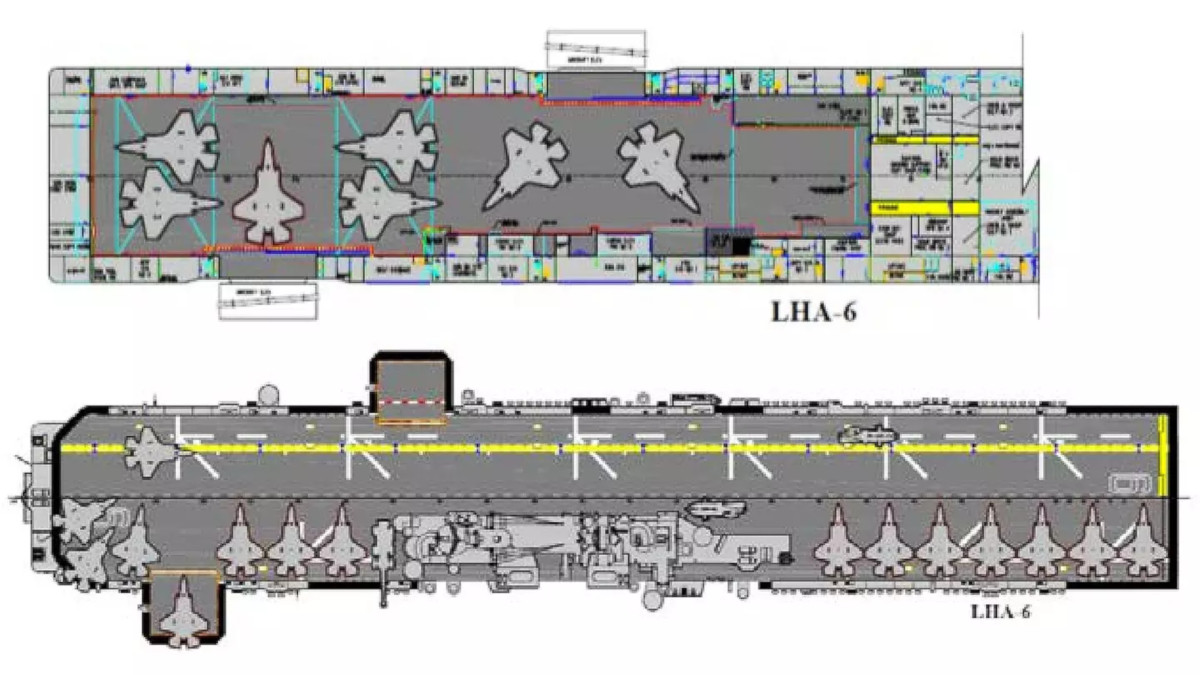
An America-class ship setup as a Lightning Carrier might have as many as between 16 and 20 F-35Bs, together with four MV-22s carrying the V-22 aerial refueling system (VARS) acting as dedicated aerial refueling tankers. It would give the amphibious assault ship an impressive amount of firepower for their size, which could allow them to ease the strain on the Navy’s notably overworked supercarriers, especially during smaller conflicts.
Separately, the Marines want to develop an advanced unmanned aircraft to serve as an airborne early warning node, which you can read about in more depth here. This could help make it more viable for a Lighting Carrier to conduct independent expeditionary aviation operations, even in higher-risk environments, in the future.
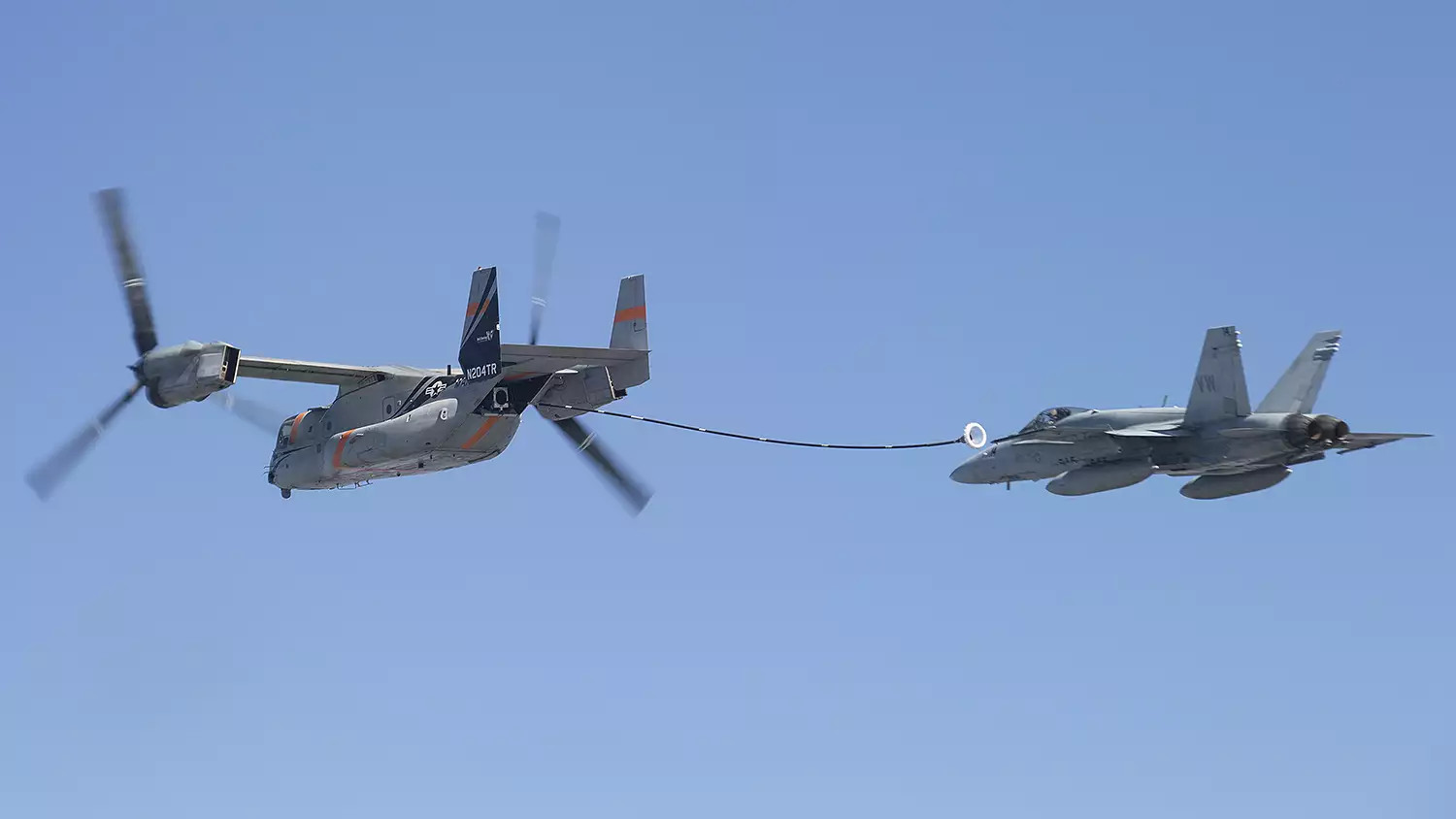
To get this critical surveillance and sensor capacity at present, the Marines have to rely on other services and their aircraft, such as the Navy’s carrier-based E-2 Hawkeyes. The F-35’s impressive sensor and electronic warfare suites could also help mitigate the need for this sensor capability, as well as additional jamming support, to begin with. However, this would also require dedicating some number of the jets on board an amphibious assault ship to this role, and keeping one airborne consistently, limiting the overall operational capacity of the force.
Lightning carriers could also embed themselves with supercarriers to offer additional capacity during larger operations. The Navy is planning to fly a mix of both stealthy F-35C Joint Strike Fighters and non-stealth F/A-18E/F Super Hornets for the foreseeable future, which means that an amphibious assault ship loaded with F-35Bs could offer an important additional compliment of 5th generation jets to the air wing during a high-end fight.
It might not be possible for Wasp-class ships to ever operate as true Lightning Carriers, both because of the physical and maintenance space required and the inability of their decks to handle the increased wear and tear of those kinds of high-tempo aviation operations. But even with 10 F-35Bs, the ships would be able to provide a significant amount of air combat capability.
In 2016, during the U.S. air campaign to drive ISIS-affiliated terrorists from the Libyan city of Sirte, the Wasp-class amphibious assault ship USS Bataan conducted a significant amount of the total strikes with just seven AV-8Bs. More recently, during its 2018 cruise to the Horn of Africa and the Middle, the USS Essex, another Wasp-class ship, was ready to send its complement of six F-35Bs to strike in Somalia if need, conducted the first-ever strikes by American F-35s in Afghanistan, and later flew additional sorties against ISIS in Iraq and Syria.
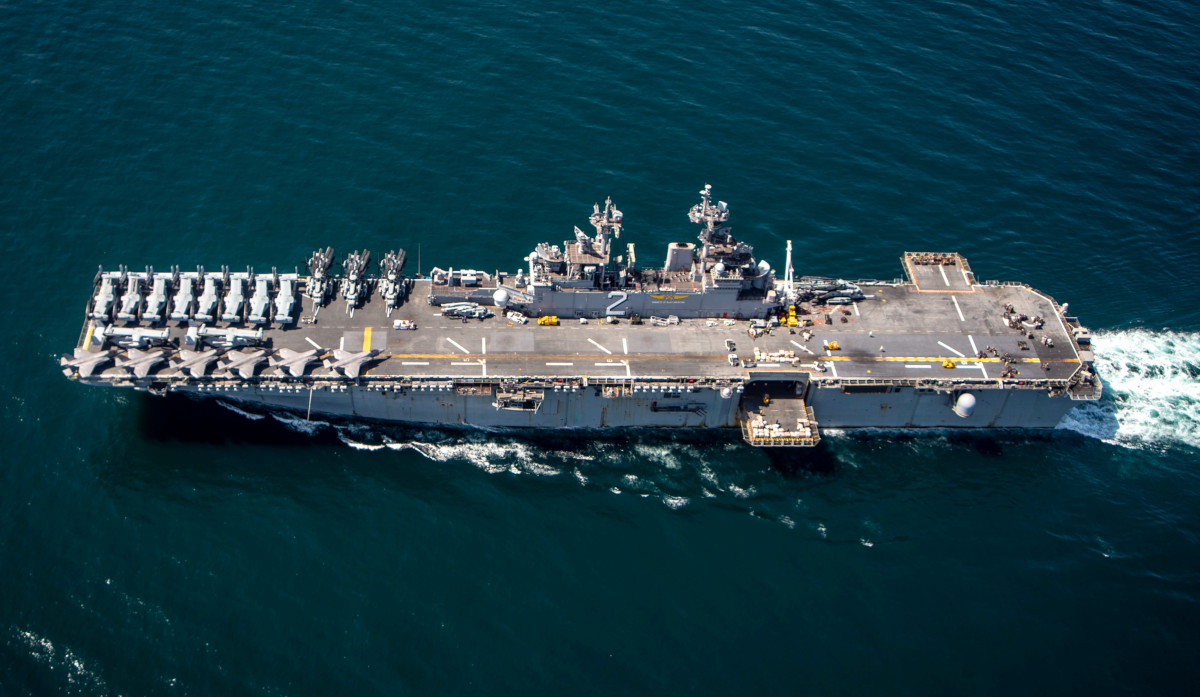
In total, Essex’s Joint Strike Fighters flew more than 100 combat sorties over both Afghanistan and Iraq and Syria across a period of 50 days, according to Task and Purpose. This number could easily have been higher with four extra jets, especially given what we know about the F-35’s readiness rates across the board. With this in mind, having more Joint Strike Fighters could actually be a requisite for generating a meaningful number of sorties during sustained combat operations.
It seems to have been no accident that Wasp appeared in the Philippines in this particular high-end configuration, either. “Together they [Wasp and the F-35s] represent an increase in military capability committed to a free and open Indo-Pacific region,” the Navy’s official announcement of the ship’s arrival added.
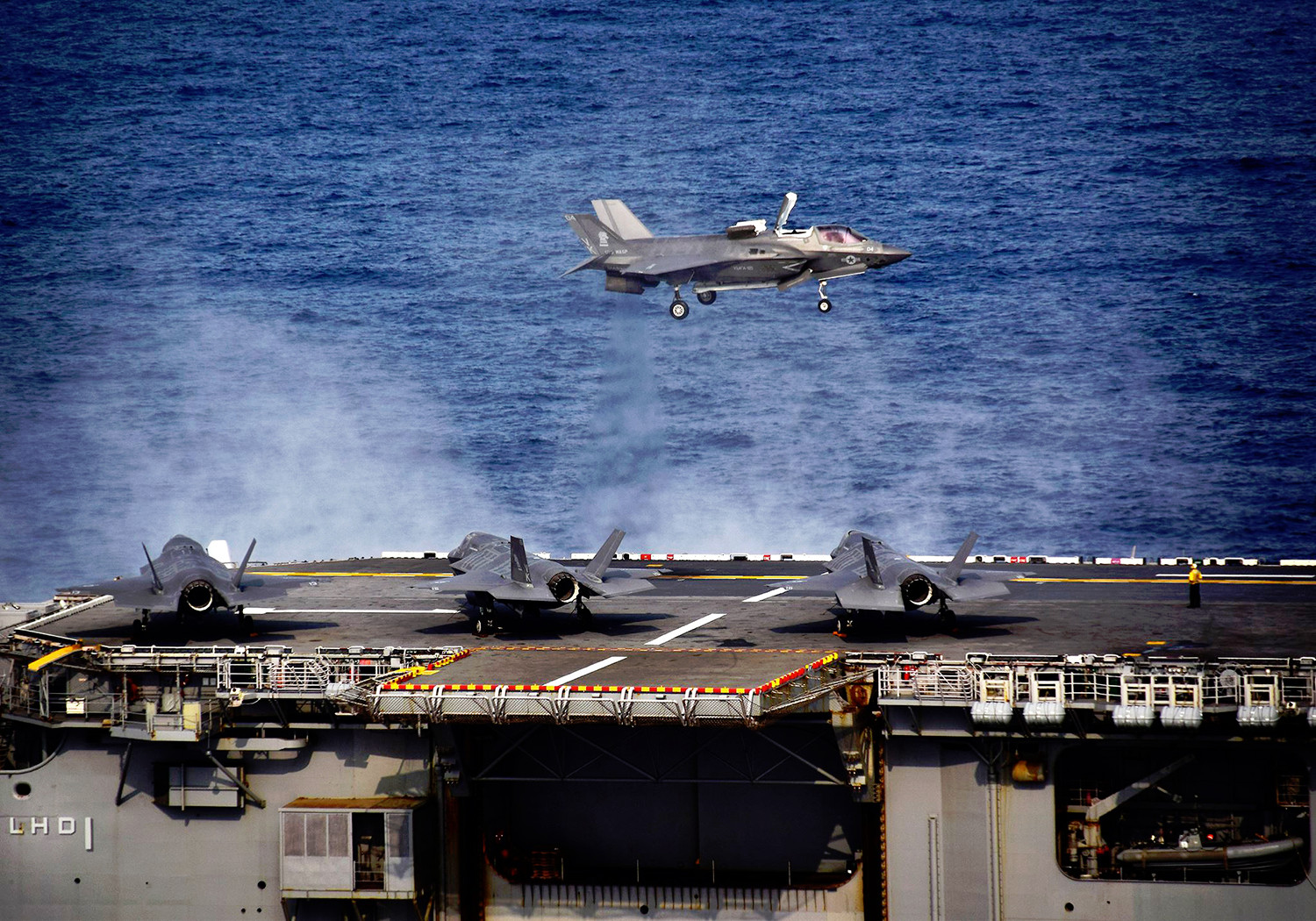
This statement seems aimed particularly at the Chinese, who have been increasingly assertive in enforcing their broad territorial claims in the South China Sea in recent months. Over the past few years, China has also notably built up a constellation of man-made islands, home now to an array of defenses, including long-range anti-ship cruise missiles and surface-to-air missiles, to further cement its claims.
In 2016, the Philippines secured an international legal ruling against China’s claims to The Scarborough Shoal, which Manila claims as its territory. The Chinese have rejected this determination and Filipino President Rodrigo Duterte has been included to largely drop the issue, at least publicly, in favor of better ties with Beijing. But it remains a major point of contention between the two parties.
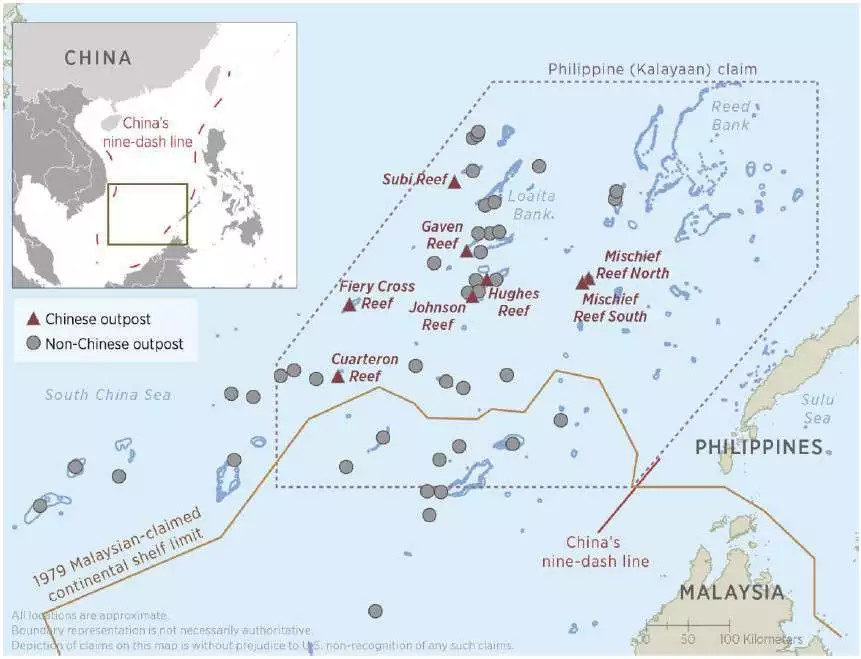
In addition, the U.S. government recently reaffirmed that it would defend Filipino forces from any attack in the South China Sea, pointedly including from the Chinese. The United States and the Philippines have had mutual defense treaty in place since 1951 and expanded those ties in 2014.
“China’s island-building and military activities in the South China Sea threaten your sovereignty, security, and therefore economic livelihood, as well as that of the United States,” U.S. Secretary of State Mike Pompeo told reporters in Manila during a visit on Mar. 1, 2019. “Any armed attack on Philippine forces, aircraft or public vessels in the South China Sea will trigger mutual defense obligations.”
Wasp, with its load of F-35Bs, is certainly a demonstration of that American commitment. It’s also a very tangible demonstration of the potential value of amphibious assault ships was larger complements of the stealth fighters to project power in higher-risk environments, at least in principle. It remains to be seen if a Wasp-class ship in this configuration can generate enough sorties for the concept to be especially useful.
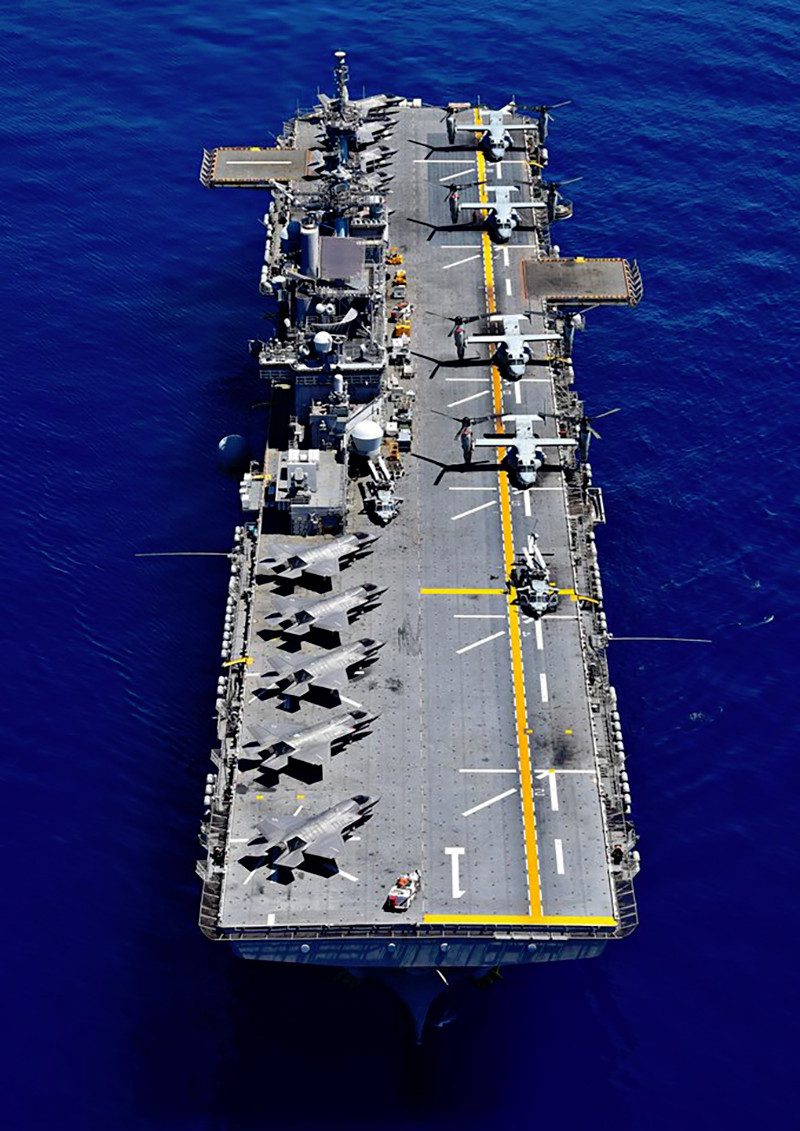
Still, Wasp’s cruise in the Pacific will provide important lessons learned toward the continued development of the Lightning Carrier concept. It could also may point to a future where amphibious assault ships deploying with at least 10 F-35s becomes the norm, especially in the Pacific region.
Contact the author: jtrevithickpr@gmail.com
